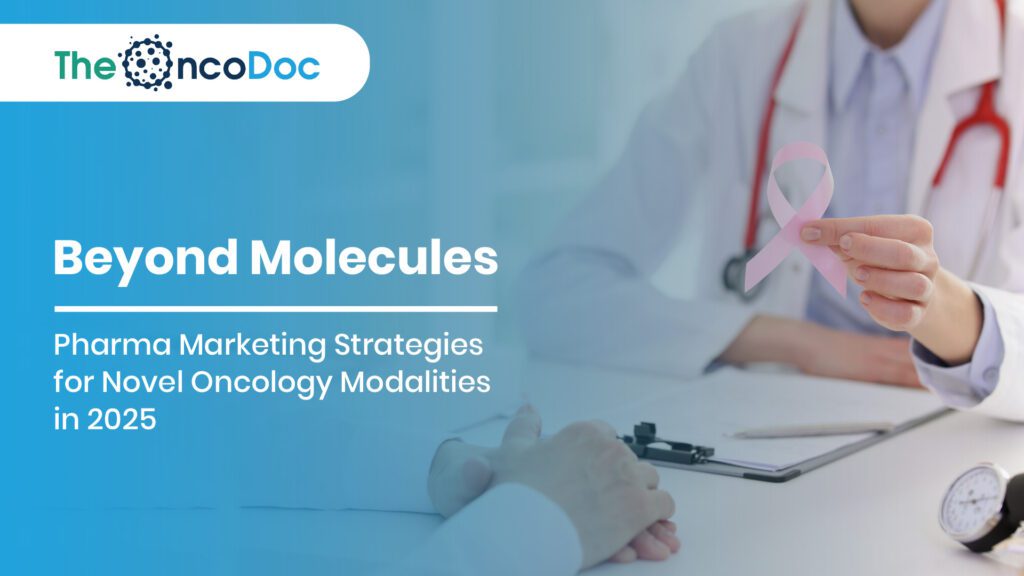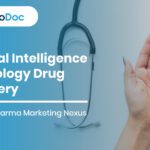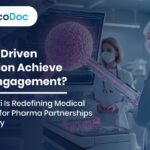Introduction: Marketing in the Era of Next-Generation Oncology
Oncology is experiencing one of the most transformative decades in its history. Treatment guidelines, patient expectations, and market dynamics are being rewritten by the advent of innovative modalities, cell and gene therapies (CGTs), antibody-drug conjugates (ADCs), and multispecific antibodies.
In fact, these cutting-edge therapies now represent 35% of active oncology clinical trials globally, a proportion that continues to grow year-on-year. The complexity of these modalities, their potential for curative outcomes, and their often-high costs present unique challenges and opportunities for pharmaceutical marketers.
The task for modern oncology pharma marketing teams is no longer limited to product launches, it’s about creating awareness ecosystems that connect scientific innovation with patient accessibility, physician trust, and policy support. Marketing must bridge the gap between complex science and everyday patient decision-making, while anticipating the emotional, financial, and logistical hurdles that come with pioneering therapies.
This article explores new marketing playbooks for novel oncology modalities in 2025, integrating AI-powered precision, omnichannel personalization, and value-based storytelling, supported by data visualization for clarity.
1. Shifting from Awareness to Comprehension
While general awareness of cancer treatment options has increased, comprehension of novel modalities is still low among patients and even some healthcare providers.
Pharma marketers must now move beyond “Know this treatment exists” to “Understand how and why it works, and why it’s relevant to you.”
For example:
- CAR-T cell therapy can be perceived as “gene editing,” which may cause fear or misconceptions. Explaining its immune system reprogramming in simple visuals improves understanding.
- ADCs need positioning not as “chemotherapy” but as precision-guided cancer-killing missiles, differentiating them from traditional cytotoxics.
Marketing Tactics:
- Animated explainer videos breaking down treatment mechanisms.
- Infographics comparing side effect profiles of traditional vs novel modalities.
- Interactive tests that allow patients and caregivers to match cancer types with appropriate therapies.
2. Hyper-Specialized Patient Segmentation
In novel modality marketing, broad segmentation doesn’t work. A non-small cell lung cancer (NSCLC) patient eligible for an ADC is vastly different from one in early-stage diagnosis considering surgery.
Segmentation Factors Include:
- Biomarker status (HER2+, BRCA mutations, PD-L1 levels)
- Prior lines of therapy
- Treatment goals (curative vs palliative)
- Socioeconomic and geographic variables affecting access
3. Educating Oncologists with “Depth on Demand” Resources
Novel modalities evolve so rapidly that even seasoned oncologists need just-in-time learning. Pharma marketing must move towards modular, searchable, and mobile-friendly clinical resources.
Examples:
- AI-curated abstracts of the latest ADC clinical data.
- Dosage calculators for CAR-T treatment protocols are available on mobile apps.
- Interactive MOA (Mechanism of Action) AR visualizations for multispecific antibodies.
This positions pharma brands as partners in medical mastery, rather than mere suppliers.
4. Real-World Evidence (RWE) as the New Currency
In the early days of novel modalities, real-world evidence can be more persuasive than clinical trial data alone. Payers, physicians, and policymakers all want proof of impact beyond controlled environments.
RWE Marketing Channels:
- Virtual advisory boards where oncologists share case outcomes.
- Data dashboards comparing hospitalization rates pre- and post-therapy adoption.
- Patient-reported outcome videos integrated into conference presentations.
5. AI-Powered Predictive Demand Mapping
Novel modalities often require specialized infusion centers, genetic testing infrastructure, or rare-disease registries. Predictive AI models can help pharma companies anticipate demand and allocate resources effectively.
Example:
If AI detects a surge in EGFR mutation testing in a specific region, marketing teams can pre-launch educational content for oncologists and patient advocacy groups there.
6. Value-Based Storytelling for High-Cost Therapies
With CGTs and ADCs often carrying six-figure price tags, pharma marketers must articulate value, not just cost. Human outcomes and long-term health economics must be incorporated into storytelling.
Narrative Structure:
- The Burden – Statistics on disease progression without the therapy.
- The Breakthrough – The science simplified.
- The Benefit – Real-world life years gained, hospitalizations avoided, productivity restored.
7. Community and Advocacy Group Integration
For novel modalities, patient advocacy groups are not optional, they’re accelerators.
Marketing should enable co-branded awareness programs with cancer societies, survivor networks, and genomic testing advocacy groups.
Benefits:
- Expands reach into niche patient communities.
- Builds trust through third-party credibility.
- Facilitates peer-to-peer education.
8. Localizing Complex Science
While ADCs and CGTs are global breakthroughs, cultural adaptation is critical. In low-literacy or rural areas, science must meet storytelling.
Localized Strategies:
- Use folk theatre or radio to explain how “immune soldiers” fight cancer.
- Translate scientific terms into relatable metaphors.
- Leverage local influencers to narrate survivor journeys.
9. Multichannel Engagement for High-Science Launches
Novel modality launches require orchestration across multiple touchpoints:
- Medical conferences for peer credibility.
- Targeted LinkedIn ads for specialist HCPs.
- YouTube shorts for patient-friendly science.
- Chatbots for quick biomarker testing guidance.
10. Leveraging Biomarker Testing as a Gateway Campaign
Many patients will never access novel therapies unless they undergo biomarker testing. Marketing must integrate testing-awareness campaigns as part of pre-launch strategies.
11. Digital Companion Platforms for Patient Retention
Novel therapies often require long-term monitoring. Pharma brands can offer digital companion apps that:
- Track side effects and alert care teams.
- Provide educational content tailored to therapy stage.
- Offer emotional support via survivor-led video content.
12. Collaborations with Tech Giants for Wearable Integration
In proactive oncology care, wearable technology is quickly becoming an essential tool. By partnering with leading tech companies, pharma can leverage real-time patient data to anticipate needs and personalize interventions.
- Smartwatches and fitness trackers can alert patients to schedule clinic visits if changes in sleep patterns, heart rate variability, or activity levels suggest therapy-related side effects.
- Continuous monitoring enables early detection of complications, reducing hospitalizations and improving outcomes.
- Data-driven insights allow pharma to enhance patient support programs, making treatment journeys safer, more responsive, and integrated into patients’ daily lives.
13. Democratizing Access Through Innovative Financing
Pharma marketing can’t ignore affordability. Strategies include:
- Co-marketing with insurers on reimbursement explainer content.
- Patient assistance program promotions.
- Public-private partnerships for subsidized access in low-income regions.
14. Emotional Analytics for Campaign Optimization
AI-powered emotional analytics enables oncology marketers to understand the true impact of their campaigns beyond clicks and impressions. For instance, a CAR-T therapy awareness ad can be analyzed to determine whether it evokes hope, fear, or confusion among patients and caregivers. Insights from sentiment analysis allow messaging to be optimized for clarity, empathy, and reassurance. Campaigns can be fine-tuned to emphasize empowerment, reduce anxiety, and build trust, ensuring that communications not only inform but also emotionally support patients throughout their treatment journey, ultimately enhancing engagement and treatment adherence.
15. Virtual Reality (VR) for Treatment Simulation
Virtual Reality offers an innovative way to make complex oncology therapies more understandable and less intimidating for patients. By transforming scientific processes into immersive visual experiences, VR can bridge the gap between medical complexity and patient comprehension.
- Use VR to visually explain complex oncology therapies in an immersive, interactive format.
- Simulate the step-by-step process of how modified immune cells or targeted drugs work in the body.
- Reduce patient anxiety by replacing abstract science with tangible, easy-to-understand visuals.
- Increase treatment acceptance through realistic, reassuring demonstrations of therapy safety and precision.
- Deploy VR in clinics, patient education centers, and awareness campaigns for maximum reach and impact
16. Continuous Engagement Post-Treatment
Pharma brands must sustain relationships after therapy completion, offering:
- Recovery nutrition guides.
- “Return to life” wellness programs.
- Periodic survivorship webinars.
17. KOL-Driven “Science Simplified” Series
Leveraging Key Opinion Leaders (KOLs) to break down complex oncology innovations into concise, 3-minute video capsules can significantly boost both physician adoption and patient trust. These bite-sized, high-impact segments translate dense scientific data on novel modalities, such as cell and gene therapies, ADCs, or multispecific antibodies, into clear, actionable insights. Filmed in accessible formats, they can be shared across medical conferences, LinkedIn, and patient platforms, ensuring reach across audiences. By combining expert credibility with simplified storytelling, this approach bridges the knowledge gap, accelerates clinical confidence, and positions pharma brands as trusted educational partners in the evolving landscape of next-generation cancer treatments.
18. Proactive Myth-Busting Campaigns
In the fast-paced world of oncology, misinformation about gene therapy, biologics, and other novel modalities can spread rapidly, fueling confusion, fear, and hesitation among patients and even healthcare providers. To counter this, pharma marketing must adopt a proactive approach, tackling misconceptions before they take root. This involves launching dedicated FAQ microsites with fact-checked, evidence-based explanations; producing influencer-led videos that translate complex science into simple, relatable narratives; and hosting interactive community Q&A events to encourage open, trust-building conversations. By combining clear, empathetic communication with credible expert voices, brands can replace myths with understanding, increase treatment acceptance, and foster well-informed decision-making.
19. Outcome-Based Contract Messaging
For payers and policy makers, marketing should highlight risk-sharing agreements where pharma is reimbursed based on patient outcomes, a powerful trust-builder.
20. The Future: Modular, Predictive, Human-Centric
By 2030, oncology marketing for novel modalities will likely be:
- Predictive (AI flags at-risk populations before symptoms appear).
- Modular (content dynamically adjusts to the patient’s treatment stage).
- Human-Centric (empathy embedded at every step).
21. AI-Enhanced Patient Journey Mapping
AI-driven patient journey mapping goes beyond simple segmentation, creating predictive pathways that anticipate patient behavior at every treatment stage.
- By analyzing electronic health records, wearable data, and patient-reported outcomes, pharma can identify moments of disengagement or risk.
- Marketing campaigns can be precisely timed to provide relevant interventions, such as reminders for follow-ups, educational content for managing side effects, or encouragement to adhere to therapy schedules.
- Insights from these predictive models allow patient support programs to dynamically adjust content delivery, improving retention and satisfaction while reducing treatment drop-offs.
22. Personalized Microlearning for Physicians and Nurses
With novel oncology modalities evolving rapidly, continuous medical education must be flexible, digestible, and highly targeted.
- Microlearning modules, delivered via mobile or web apps, allow oncologists and nursing staff to access concise, case-based learning at the point of care.
- Examples include 5-minute explainer videos for ADC administration, interactive AR simulations for CAR-T infusion safety, or AI-curated literature digests.
- Personalized learning paths can adapt based on the clinician’s specialty, patient mix, or prior engagement, ensuring healthcare teams stay confident and current.
23. Social Listening and Patient-Centric Feedback Loops
Modern oncology marketing must be attuned to patient and caregiver sentiment across digital platforms.
- Social listening tools powered by AI can monitor forums, patient communities, and social media to identify concerns, misconceptions, or emerging needs.
- Feedback loops can inform campaign adjustments, content tone, and educational priorities. For example, if patients express confusion about genetic testing, marketers can deploy targeted explainer content or chatbot interactions to clarify the process.
- Incorporating patient feedback into campaign design also strengthens trust and positions pharma as a responsive partner in care, not just a provider of therapies.
24. Blockchain for Transparent Patient Data Engagement
Data privacy and security remain top concerns in personalized oncology marketing. Blockchain technology offers a solution for secure, verifiable, and patient-consented data sharing.
- Patients can control which data points, biomarkers, therapy adherence, side effects, are shared with pharma for research or support programs.
- Blockchain promotes confidence between patients, physicians, and regulatory agencies by guaranteeing openness in data usage.
- Marketers can leverage aggregated, anonymized insights to refine campaign targeting, predict demand, and validate real-world evidence without compromising privacy, combining ethical responsibility with actionable intelligence.
Conclusion: Integrating Science, Empathy, and Precision
Marketing novel oncology modalities in 2025 and beyond is no longer about simple promotion. The focus is on orchestrating an entire ecosystem:
- Patients who understand their treatment options and are guided through complex journeys with digital companions, emotional support, and VR-enabled simulations.
- Physicians and nurses equipped with microlearning modules, AI-driven insights, and accessible RWE to make confident clinical decisions.
- Payers and policymakers convinced of the therapy’s long-term value through outcome-based contracts and transparent health economics.
- Communities, advocacy groups, and tech partners engaged to expand reach, improve adherence, and reduce disparities.
The future winners in oncology marketing will seamlessly blend cutting-edge science, AI-driven precision, emotional intelligence, and ethical responsibility, ensuring that life-changing therapies reach the patients who need them most, at the right time, in the most understandable and supportive way. Marketing becomes a bridge between breakthrough science and human impact, turning complex innovations into tangible improvements in patient lives.
The Oncodoc team is a group of passionate healthcare and marketing professionals dedicated to delivering accurate, engaging, and impactful content. With expertise across medical research, digital strategy, and clinical communication, the team focuses on empowering healthcare professionals and patients alike. Through evidence-based insights and innovative storytelling, Hidoc aims to bridge the gap between medicine and digital engagement, promoting wellness and informed decision-making.



